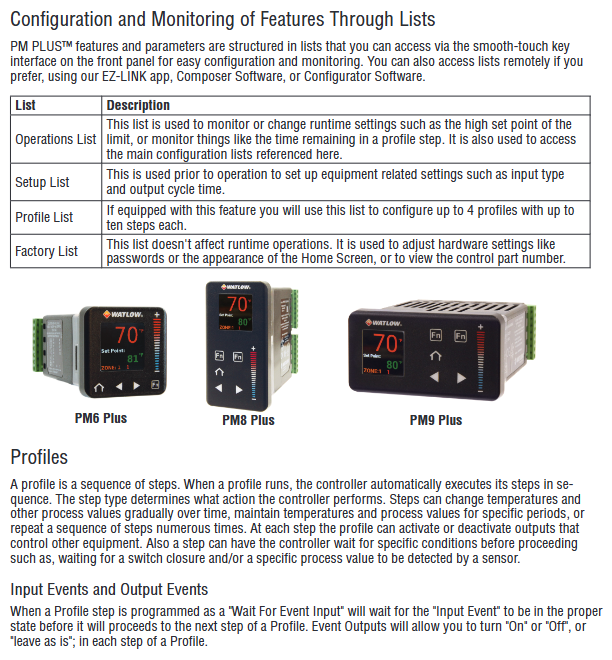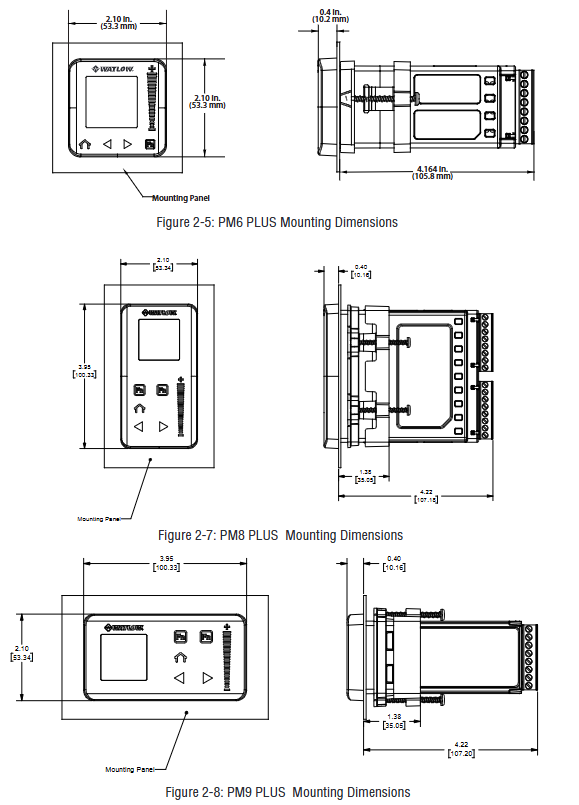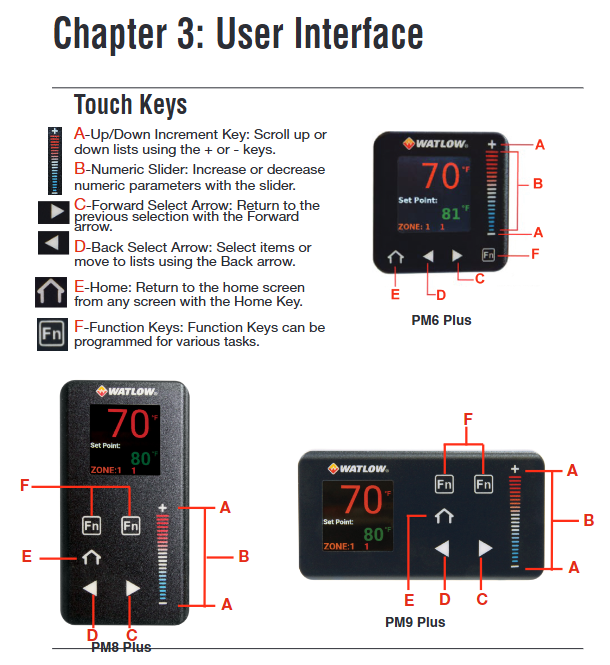

K-WANG


Watlow PM PLUS ™ PID/Integrated Limit Controller
Watlow PM PLUS ™ PID/Integrated Limit Controller
Product Core Overview
Watlow PM PLUS ™ It is an enhanced PID/integrated limit controller that optimizes user experience and functional scalability while being compatible with the previous generation EZ-ZONE PM controller. The product is positioned as an industrial grade temperature and process control, supporting single/dual PID control loops and integrating functions such as limit control, timing, and curve programming. It is widely used in semiconductor manufacturing, chemical reactions, equipment heating, and other scenarios. Its core advantages include Bluetooth wireless configuration, intuitive touch operation, support for multiple communication protocols, and comprehensive security authentication, which can adapt to the precise control needs in complex industrial environments.
Core features:
Compatibility and Upgradeability: Fully compatible with the wiring and parameter settings of EZ-ZONE PM, can be replaced without hardware modification, and upgraded with smooth touch keyboard, multilingual display (English/German/Spanish) and other operations.
Control capability: Supports PID (including P/PI/PD mode), switch control, curve programming (4 curves, a total of 40 steps), equipped with TRU-TUNE+adaptive algorithm and automatic tuning function to improve dynamic control accuracy.
Communication and wireless functions: Supports Bluetooth (via EZ-LINK mobile application), Modbus RTU/TCP, EtherNet/IP, DeviceNet and other protocols, allowing remote configuration of parameters and monitoring, reducing on-site wiring dependence.
Safety and Certification: Certified by UL, CSA, CE, RoHS, FM, etc., some models support Class 1, Zone 2 hazardous environments, integrate limit control and multiple alarms to ensure equipment and personnel safety.
Product model and core configuration
(1) Model classification and structure
The product is divided into three series based on installation size and function. The core model parameters are defined by a 14 digit configuration code, and the key dimensions are as follows:
Classification, specific specifications, applicable scenarios
Installation size: 1/16 DIN (PM6), 1/8 DIN vertical (PM8), 1/8 DIN horizontal (PM9). Different panel space requirements, 1/16 DIN is suitable for compact scenarios, and 1/8 DIN is suitable for multi parameter display requirements
Core function - PID basic type (C/R/T/J/N): including universal input, curve programming (some models), and timing function
-Integrated limit type (L/M): Additional support for sensor backup, over limit protection, output 4 fixed limit control - Basic type: Single heating/cooling control
-Integrated type: Scenarios that require dual safety protection (such as high-temperature furnaces and hazardous material heating)
The power supply and I/O power supply can be selected from 100-240V AC or 20-28V AC/12-40V DC. The digital I/O supports 2-point or 6-point expansion to adapt to the global power grid. Multiple I/O point models can be connected to external trigger signals (such as emergency stop and start switches)
Output types support switch DC, mechanical relay (5A), SSR (0.5A), NO-ARC relay (15A), universal process output (0-10V/4-20mA) - NO-ARC relay: high-power resistive load (such as large heaters)
-Universal process output: signal retransmission to recorder or PLC
(2) Core hardware specifications
Category detailed parameters
Input Characteristics - Universal Input: Thermocouple (J/K/T/E, etc.), RTD (100 Ω/1k Ω), Process Signal (0-20mA/0-10V)
-Input accuracy: ± 0.1% range (typical value), temperature stability ± 100ppm/° C
-Sensor backup: supports dual sensor switching, automatically switches to backup sensor in case of failure
Output Capacity - Maximum Output: 15A NO-ARC Relay (AC Load Only)
-Process output: 0-10V (minimum 1k Ω load) or 4-20mA (maximum 800 Ω load), accuracy ± 20 μ A/± 10mV
Environmental adaptability - Operating temperature: 0-65 ° C (non condensing)
-Protection level: Front panel IP67/IP4X (indoor)
-Anti interference: Compliant with IEC 61000-4 series standards, anti-static and radio frequency interference resistant

Installation and wiring specifications
(1) Installation requirements
Panel opening and fixing
Size standards: 1/16 DIN (PM6) opening 45 × 45mm, 1/8 DIN (PM8/9) opening 45 × 92mm (vertical)/92 × 45mm (horizontal).
Installation steps: Remove the terminal and fixing ring → Insert the controller from the front of the panel → Align the fixing ring and tighten the screws (torque 3-4 in lbs) → Reinstall the terminal.
Environmental restrictions: Avoid corrosive gases and high vibration environments, install vertically to ensure heat dissipation, and reserve a spacing of ≥ 30mm for parallel installation of multiple units.
Power supply and wiring safety
Power adaptation: High power models (1/2) are connected to 100-240V AC, while low-power models (3/4) are connected to 20-28V AC/12-40V DC, and must match the power type indicated on the equipment label.
Wiring specifications: Wire specifications are 12-30 AWG, terminal torque is 5.0 in lb, unused terminals need to be empty, analog input and power/digital signals need to be isolated and wired to avoid grounding loops.
Attention to hazardous environments: Class 1, Zone 2 models (with "12" at the end of the configuration code) require the use of explosion-proof switches. It is prohibited to plug or unplug wiring when powered on, and replacement parts must comply with hazardous environment certification.
(2) Key wiring example
Sensor wiring
Thermocouple: Connect the negative electrode (usually red) to the S1/S2 terminal, and the extension wire should be consistent with the thermocouple material (such as K-type extension wire for K-type).
RTD: 2/3 wire system, 3-wire system needs to ensure that the resistance of the three leads is consistent (≤ 20 Ω), S1 is connected to a white lead to compensate for the lead resistance.
Process signal: 4-20mA signal connected to+R1/- S1 terminal, 0-10V signal connected to+T1/- S1 terminal, requiring separate shielded wiring.
Output and communication wiring
NO-ARC relay: only connected to AC loads (85-264V AC), load current ≤ 15A, prohibited from series use, cycle time ≥ 5 seconds.
Communication wiring: RS-485 uses twisted pair cables (T+/R+connected to B, T -/R - connected to A), and a 120 Ω terminal resistor needs to be added at the end of the bus. The distance between the communication line and the power line should be ≥ 305mm.
Digital I/O: 2-point I/O model (configuration code 2/4) supports dry contact or 3-36V DC input, 6-point I/O model (configuration code C/D/M/N) expandable switch output, with a maximum load of 1.5A per channel.
Operating interface and core functions
(1) User interface
Touch buttons and display
Key functions: Home button (return to home page), left and right buttons (menu navigation), increase and decrease buttons (parameter adjustment), custom function buttons (F1/F2, can set start/stop curves, reset alarms, etc.).
Display mode: default display of process values (such as temperature), set values, and regions, supporting 4 themes (such as white background, high contrast blue background), customizable display parameters (such as output power, remaining time).
Message prompt: Automatically switch display in case of alarm/error, such as "Limit High" or "Input Error". The lock alarm can be cleared by pressing the home button.
Menu Structure
Operations List: Real time monitoring and adjustment of operating parameters (such as set values, manual power).
Setup: Configure basic parameters such as input type, control algorithm, alarm threshold, etc.
Profile: Edit curve steps (heating/holding/waiting for events).
Factory List: Calibration, password locking, factory reset (permission required).
(2) Core function operation
PID control and tuning
Auto tuning: Enter "Operations - Autotune" and select "Yes". The controller aims to achieve 90% of the set value and automatically calculates parameters such as proportional band and integration time. During the tuning period, it outputs 100% power and ensures load safety.
TRU-TUNE+adaptive: enabled in the "Setup Control Loop", automatically optimizes PID parameters by monitoring process value fluctuations, suitable for scenarios with dynamic load changes (such as batch production).
Manual tuning: If the automatic tuning effect is not good, you can manually adjust the Heat Prop. Band and Time Integral. It is recommended to set the integration time to 0 first and gradually reduce it after stabilization to eliminate static errors.
Curve Programming (Ramp/Soak)
Curve configuration: Enter the "Profile List", each curve supports 10 steps, including Time/Ramp Rate, Soak, Wait for Event/Process, Jump, etc.
Example: Set the target temperature for "Step 1 (heating up)" to 150 ° C for 30 minutes; Step 2 (insulation) lasts for 60 minutes; Set 'Step 3' to 'Hold' to maintain the final temperature.
Startup method: It can be remotely started through function keys, numerical input, or communication. It can pause/resume during operation. If the restart time is ≤ the set "Power Off Time" after power failure, the curve can be continued.
Alarm and limit control
Alarm configuration: Supports 4 alarm channels, including process alarm (fixed threshold), deviation alarm (relative set value), and can be set to lock/non lock, shield (not triggered temporarily when starting/set value changes).
Limit control: The integrated limit model (L/M) supports high/low limit, and automatically cuts off the output when it exceeds the limit. It needs to be manually reset (through buttons, digital inputs, or communication), and outputs 4 fixed limit dedicated.
Current monitoring: Equipped with a current transformer (CT) input, it can detect open/short circuits in the heater, trigger the "Heater Error" alarm, and protect the load and controller.

Communication and Remote Configuration
(1) Communication Protocol and Settings
Protocol configuration key points applicable scenarios
Bluetooth (EZ-LINK application) devices can be paired through Bluetooth after being powered on, supporting parameter reading and writing, alarm viewing, curve downloading, and quick on-site configuration without the need for physical wiring, reducing wiring costs
Modbus RTU baud rate 1200-19200bps, addresses 1-247, supports function codes 03 (read register), 06 (write single register), and 16 (write multiple registers) to connect PLC or HMI and achieve multi device networking
EtherNet/IP supports DHCP or fixed IP, with a maximum of 40 members in the I/O assembly, capable of real-time transmission of process values and control commands in industrial Ethernet environments, requiring high-speed data exchange
DeviceNet node address 0-63, baud rate 125/250/500kbps, supports implicit/explicit communication, compatible with Rockwell and other brands of PLCs, suitable for device layer networking
(2) Remote configuration process (using Bluetooth as an example)
Download the EZ-LINK app (supports iOS/Android), turn on the controller Bluetooth ("Setup - Global - Bluetooth" set to "On").
Search for and pair devices within the application, enter "Parameter Configuration", and modify input types (such as thermocouple J-type), PID parameters, and alarm thresholds.
Save parameters to the device or local (supports 2 sets of user configurations), monitor process values and output power in real-time during operation, and receive alarm push notifications.
Maintenance and troubleshooting
(1) Daily maintenance
Regular inspection: monthly cleaning of panels and heat sinks, quarterly tightening of terminals (to avoid cold flow loosening), annual calibration of input/output (via the "Factory Calibration" menu, requiring a standard signal source).
Parameter backup: Save the configuration to User Set 1/2 through "Setup - Global - Save Settings As" to avoid resetting after a malfunction.
Firmware Upgrade: Supports firmware upgrade through communication port. The latest firmware and upgrade tool must be downloaded from the Watlow official website. Power off is prohibited during the upgrade process.
(2) Common fault handling
Possible causes and solutions for the fault phenomenon
No display/output power supply not connected, fuse burned out, loose terminals. Check the power supply voltage and fuse (Slot C terminal 98/99), re tighten the terminals, and replace the fuse (matching model required)
The temperature cannot reach the set value due to heating output fault, improper PID parameters, sensor error check output wiring and load, re perform automatic tuning, calibrate sensor offset ("Setup - Analog Input - Calibration Offset")
Alarm cannot be cleared. Alarm not cleared, alarm locked, parameter error confirmation process value returned to safe range. Clear it through "Operations - Alarm - Clear Alarm" and check the alarm type configuration
Communication failure: Address/baud rate mismatch, wiring error, interference with unified device communication parameters. Check RS-485 polarity (A/B lines), route away from power lines, and add terminal resistors

- YOKOGAWA
- Energy Access
- Renewable Integration
- Energy Subsidies
- Energy and Water
- Net zero emission
- Energy Security
- Critical Minerals
- A-B
- petroleum
- Mine scale
- Energy and Gender
- Covid-19
- man-machine
- Reliance
- ADVANCED
- SEW
- ProSoft
- WATLOW
- Kongsberg
- FANUC
- VSD
- DCS
- PLC
- Sewage treatment
- cement
- Yaskawa
- Woodward
- BOSCH Rexroth
- MOOG
- General Electric
- American NI
- Rolls-Royce
- CTI
- Honeywell
- EMERSON
- Automobile market
- xYCOM
- Motorola
- architecture
- Industrial information
- New energy
- electricity
- Construction site
- HIMA
- ABB
- Rockwell
- Schneider Modicon
- Siemens
- MAN
- GE
- TRICONEX
- Control Wave
- ALSTOM
- AMAT
- STUDER
- KONGSBERG
- MOTOROLA
- DANAHER MOTION
- Bentley
- Galil
- EATON
- MOLEX
- Triconex
- DEIF
- B&W
- ZYGO
- Aerotech
- DANFOSS
- KOLLMORGEN
- Beijer
- Endress+Hauser
- schneider
- Foxboro
- KB
- REXROTH
- YAMAHA
- Johnson
- Westinghouse
- WAGO
- TOSHIBA
- TEKTRONIX
- BENDER
- BMCM
- SMC
-
GE Hydran M2-X Enhanced Monitoring
-
ABB REG316 1mrk000809-GA Numerical Generator Protection
-
ABB RED670 1MRK004810 Line differential protection
-
GE SR750-P5-G5-S5-HI-A20-R-E Feeder protection system
-
ABB PFTL301E-1.0KN 3BSE019050R1000 PillowBlock Load cells
-
Kollmorgen S33GNNA-RNNM-00 - Brushless Servo Motor
-
Kollmorgen 6sm56-s3000-g-s3-1325 - Servo Motor
-
Kollmorgen AKM52K-CCCN2-00 - Servo Motor
-
Kollmorgen PSR3-230/75-21-202 - Power Supply
-
Kollmorgen akm24d-anc2r-00 - Servo Motor
-
Kollmorgen AKM22E-ANCNR-00 - Servo Motor
-
Kollmorgen S60300-550 - Servo Drive
-
Kollmorgen B-204-B-21 - Servomotor
-
Kollmorgen AKM21E-BNBN1-00 - Servo Motor
-
Kollmorgen TT2953-1010-B - DC Servo Motor
-
Kollmorgen pa8500 - Servo Power Supply
-
Kollmorgen BDS4A-210J-0001-207C2 - Servo Drive
-
Kollmorgen TTRB1-4234-3064-AA - DC Servo Motor
-
Kollmorgen MH-827-A-43 - Servo Motor
-
Kollmorgen AKM24D-ACBNR-OO - Servo Motor
-
Kollmorgen 00-01207-002 - Servo Disk DC Motor
-
Kollmorgen AKM21C-ANBNAB-00 - Servo Motor
-
Kollmorgen PSR3-208/50-01-003 - Power Supply
-
Kollmorgen 6SM56-S3000 - Servo Motor
-
Kollmorgen DBL3H00130-B3M-000-S40 - Servo Motor
-
Kollmorgen 6SN37L-4000 - Servo Motor
-
Kollmorgen AKM65K-ACCNR-00 - Servo motor
-
Kollmorgen 6SM56-L3000-G - Servo Motor
-
Kollmorgen AKMH43H-CCCNRE5K - Servo Motor
-
Kollmorgen PSR4/52858300 - Power Supply
-
Kollmorgen KBM-79H03-E03 - Direct Drive Rotary Motor
-
Kollmorgen AKM33E-ANCNDA00 - Servo Motor
-
Kollmorgen U9M4/9FA4T/M23 - ServoDisc DC Motor
-
Kollmorgen AKM13C-ANCNR-00 - Servo Motor
-
Kollmorgen AKM43L-ACD2CA00 - Servo Motor
-
Kollmorgen AKM54K-CCCN2-00 - Servo Motor
-
Kollmorgen M-605-B-B1-B3 - Servo Motor
-
Kollmorgen AKD-P00606-NBAN-0000 - Rotary Drive
-
Kollmorgen 6SM-37M-6.000 - Servo Motor
-
Kollmorgen A.F.031.5 - Sercos Interface Board
-
Kollmorgen 918974 5054 - Servo PWM
-
Kollmorgen U12M4 - ServoDisc DC Motor
-
Kollmorgen AKD-B00606-NBAN-0000 - Servo Drive
-
Kollmorgen MV65WKS-CE310/22PB - Servo Drive
-
Kollmorgen 65WKS-CE310/22PB - Servo Drive
-
Kollmorgen EM10-27 - Module
-
Kollmorgen S64001 - Servo Drive
-
Kollmorgen CR03200-000000 - Servo Drive
-
Kollmorgen 6SM57M-3000+G - Servo Motor
-
Kollmorgen BDS4 - Servo Drive
-
Kollmorgen AKD-P00306-NBEC-000 - Servo Drive
-
Kollmorgen AKD-B01206-NBAN-0000 - Servo Drive
-
Kollmorgen STP-57D301 - Stepper Motor
-
Kollmorgen 6SM37L-4.000 - Servo Motor
-
Kollmorgen 44-10193-001 - Circuit Board
-
Kollmorgen PRDR9SP24SHA-12 - Board
-
Kollmorgen PRD-AMPE25EA-00 - Servo Drive
-
Kollmorgen DBL3N00130-0R2-000-S40 - Servo Motor
-
Kollmorgen S406BA-SE - Servo Drive
-
Kollmorgen AKD-P00607-NBEI-0000 - Servo Drive
-
Kollmorgen AKD-P01207-NBEC-0000 - Servo Drive
-
Kollmorgen CR03550 - Servo Drive
-
Kollmorgen VSA24-0012/1804J-20-042E - Servo Drive
-
Kollmorgen N2-AKM23D-B2C-10L-5B-4-MF1-FT1E-C0 - Actuator
-
Kollmorgen 04S-M60/12-PB - Servo Drive
-
Kollmorgen H33NLHP-LNW-NS50 - Stepper Motor
-
Kollmorgen A-78771 - Interlock Board
-
Kollmorgen AKM43E-SSSSS-06 - Servo Motor
-
Kollmorgen AKD-P00607-NBEC-0000 - Servo Drive
-
Kollmorgen E21NCHT-LNN-NS-00 - Stepper Motor
-
Kollmorgen cr10704 - Servo Drive
-
Kollmorgen d101a-93-1215-001 - Motor
-
Kollmorgen BDS4A-203J-0001-EB202B21P - Servo Drive
-
Kollmorgen MCSS23-6432-002 - Connector
-
Kollmorgen AKD-P01207-NACC-D065 - Servo Drive
-
Kollmorgen CK-S200-IP-AC-TB - I/O Adapter and Connector
-
Kollmorgen CR10260 - Servo Drive
-
Kollmorgen EC3-AKM42G-C2R-70-04A-200-MP2-FC2-C0 - Actuator
-
Kollmorgen BDS5A-206-01010-205B2-030 - Servo Drive
-
Kollmorgen s2350-vts - Servo Drive
-
Kollmorgen AKM24D-ANC2DB-00 - Servo Motor
-
Kollmorgen E31NCHT-LNN-NS-01 - Stepper Motor
-
Kollmorgen PRD-0051AMPF-Y0 - Servo Board
-
Kollmorgen TB03500 - Module
-
Kollmorgen 60WKS-M240/06-PB - Servo Drive
-
Kollmorgen M21NRXC-LNN-NS-00 - Stepper Motor
-
Kollmorgen H-344H-0212 - Servo Motor
-
Kollmorgen MCSS08-3232-001 - Connector
-
Kollmorgen AKM33H-ANCNC-00 - Servo Motor
-
Kollmorgen PA-2800 - Power Supply
-
Kollmorgen MTC308C1-R1C1 - Servo Motor
-
Kollmorgen PRDR0091300Z-00 - Capacitor Board
-
Kollmorgen BDS4A-206J-0024/01502D79 - Servo Drive
-
Kollmorgen S20330-VTS - Servo Drive
-
Kollmorgen S20250-CNS - Servo Drive
-
Kollmorgen SBD2-20-1105-WO - Servo Drive Board
-
Kollmorgen M405-C-A1--E1 - Servo Motor
-
Kollmorgen PRD-PB805EDD-00 - Servo Drive
-
Kollmorgen 6SM57S-3.000-J-09-HA-IN - Servo Motor
-
Kollmorgen AKM33H-ANCNDA-00 - Servo Motor
-
Kollmorgen PCB-00030200-04 - PCB
-
Kollmorgen H22SSLB-LNN-NS-02 - Stepper Motor
-
Kollmorgen BJRL-20012-110001 - Module
-
Kollmorgen BDS4A-206J-0001404A - Servo Drive
-
Kollmorgen H-342-H-0802 - Servo Motor
-
Kollmorgen CR10561 - Servo Drive
-
Kollmorgen BDS5A-206-00010-205B2-030 - Servo Drive
-
Kollmorgen BDS5A-206-00010-207B-2-030 - Servo Drive
-
Kollmorgen mcss08-3224-001 - Connector
-
Kollmorgen M-207-B-23-B3 - Servo Motor
-
Kollmorgen PRD-0041200Z-S0 - Encoder/Resolver Card
-
Kollmorgen MH-225-G-61 - Motor
-
Kollmorgen MT308B1-T1C1 - Servo Motor
-
Kollmorgen BDS4A-240J-0001604C83 - Servo Drive
-
Kollmorgen 6SM57-S-3000 - Servo Motor
-
Kollmorgen N-T31V-15-5B-6-MF3-FT1E-C251 - Actuator
-
Kollmorgen PRD-0051AMPA-X0 - Servo Board
-
Kollmorgen CF-SS-RHGE-09 - Cable
-
Kollmorgen DIGIFAS7204 - Servo Drive
-
Kollmorgen S30101-NA - Servo Drive
-
Kollmorgen DIGIFAS7201 - Servo Drive
-
Kollmorgen PRD-0051AMPA-Y0 - Servo Board
-
Kollmorgen AKM23D-EFCNC-00 - Servo Motor
-
Kollmorgen SE10000 - Servo Drive
-
Kollmorgen PSR4/5A-112-0400 - Power Supply
-
Kollmorgen AKM31H-ANCNC-01 - Servo Motor
-
Kollmorgen M-203-B-93-027 - Servo Motor
-
Kollmorgen CP-SS-G1HE-05 - Connector




